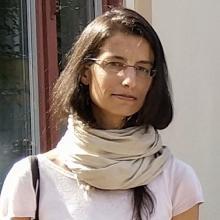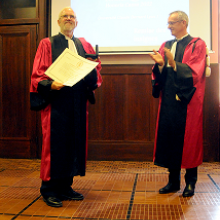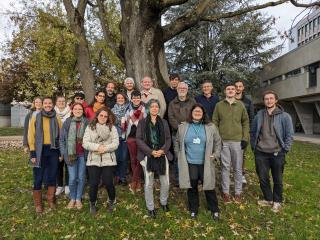Bioinformatics, Phylogeny and Evolutionary Genomics Group
Members
Maîtresse de conférences
UCBL
Tel: 04 72 44 84 87

Professeure des universités
UCBL
Tel: 33 04 26 23 44 76
Doctorante
UCBL
Enseignant-chercheur CPJ
UCBL

Directeur de recherche
CNRS
Tel: 33 04 72 44 62 97

Professeur d'université émérite
UCBL
Tel: 04 72 44 85 60
Ingénieur d'études CDD
CNRS

Directeur de recherche
CNRS
Tel: 33 04 72 43 11 67

Maîtresse de conférences
UCBL
Tel: 33 04 72 43 29 18
Doctorante
UCBL

Chargée de recherche
CNRS
Tel: 33 04 72 44 85 60

Directeur de recherche
CNRS
Tel: 04 72 44 84 87

Chargée de recherche
CNRS
Tel: 04 72 43 13 44

Directeur de recherche
CNRS

Maître de conférences
UCBL
Tel: 04 72 43 35 83

Chargée de recherche
CNRS
Tel: 04 72 44 81 42
Doctorant
CNRS

Directeur de recherche
CNRS
Tel: 33 04 72 44 62 96

Chargée de recherche
CNRS
Tel: 04 72 43 26 28
Doctorant
UCBL

Chercheur invité
UCBL
Our group focuses on two main axes: phylogenomics (i.e. the inference of evolutionary history based on genomics data) and evolutionary genomics (understanding the molecular and population processes that drive genome evolution). We see genomes both as a subject of research (how do genomes evolve, why are they structured the way they are?), but also as a main source of empirical knowledge about the macroevolutionary patterns (what do they tell us about the history of life on Earth?), or about the phenotypes and life-history strategies of organisms. Our works heavily rely on methodological developments (bioinformatics, modeling and statistical inference).
Evolution of genome architecture and expression
Genomes are the result of a long-term evolutionary process, shaped by multiple evolutionary forces. Some genomic features are adaptive (i.e. are beneficial for the fitness of organisms), others result from non-adaptive processes (random drift and biased gene conversion - BGC) or are caused by conflicts between multiple levels of selection (e.g. meiotic drive or the spread of selfish genetic elements). We explore different aspects of genome architecture (base composition landscapes, genome structure and size, impact of transposable elements, …) or functioning (gene expression, lncRNAs, epigenetic landscapes, …), and try to disentangle the relative contribution of adaptive and non-adaptive processes to their evolution. For this purpose, we consider both the molecular mechanisms (mutation, repair, recombination) and the population processes (selection, drift, BGC, …) that shape genetic variation.
Phylogenomics
We are interested in reconstructing the history of life on Earth. This research unfolds along several axes. First, we develop phylogenomic databases of aligned genetic sequences (e.g. BIBI, RiboDB or HOGENOM). Second, we conduct methodological research on how to accurately reconstruct deep phylogenies, infer divergence times, reconstruct ancestral genetic sequences, gene repertoires and life-history traits. This methodological work is translated into publicly available software programs (e.g. SeaView, PhyloBayes, Coevol). Finally, we apply these approaches to several important problems, among which: reconstructing the phylogeny of animals, of archaea, or the global tree of life; using phylogenies and ancestral gene repertoires to investigate the evolution of complex systems and the emergence of molecular and cellular functions in the three domains of life; reconstructing ancestral genetic sequences, a research activity that has industrial and biotechnological applications.
Teaching and outreach
We teach at University Lyon 1 (Master Bioinfo@Lyon), INSA, ENS Lyon, we organize bioinformatics internships. We regularly give conferences on evolution (tree of life, human evolution, genetic diversity, …).
Prospective students and postdocs are invited to apply, as we often welcome visitors for internships or research projects.
Keywords: Molecular evolution and Population Genomics; Phylogenomics; Computational Genomics; Comparative genomics; Bioinformatics; Statistical inference.
Publications
Display of 511 to 540 publications on 1110 in total
Simplified detection of food-borne pathogens: An in situ high affinity capture and staining concept
Journal of Microbiological Methods . 91 : 501--505
Journal article
see the publicationTime for order in microbial systematics
Trends in Microbiology . 20 : 209-210
Journal article
see the publicationLes défis de la systématique face au monde microbien
incollection . 328 : 49-52
Journal article
see the publicationComparative genomic analysis of the DUF71/COG2102 family predicts roles in diphthamide biosynthesis and B12 salvage
Biology Direct . 7 : 1--13
Journal article
see the publicationA comparative analysis of the amounts and dynamics of transposable elements in natural populations of Drosophila melanogaster and Drosophila simulans.
Journal of Environmental Radioactivity . 113 : 83-86
Journal article
see the publicationMolecular organization, biochemical function, cellular role and evolution of NfuA, an atypical Fe-S carrier.
Molecular Microbiology . 86 ( 1 ) : 155-71
Journal article
see the publicationSpotlight on the Thaumarchaeota
The International Society of Microbiologial Ecology Journal . 6 : 227-230
Journal article
see the publicationThe Paramecium Germline Genome Provides a Niche for Intragenic Parasitic DNA: Evolutionary Dynamics of Internal Eliminated Sequences.
PLoS Genetics . 8 ( 10 ) : e1002984
Journal article
see the publicationReNaBi-IFB : The French Bioinformatics Infrastructure
EMBNet.journal . 18 : 12-13
DOI: 10.14806/ej.18.1.502
Journal article
see the publicationWhat genomes have to say about the evolution of the Earth
Gondwana Research . 21 : 483-494
Journal article
see the publicationHorizontal gene transfer of a chloroplast DnaJ-Fer protein to Thaumarchaeota and the evolutionary history of the DnaK chaperone system in Archea
BMC Evolutionary Biology . 12 : 226
Journal article
see the publicationDisentangling the effects of breakdown of self-incompatibility and transition to selfing in North-American Arabidopsis lyrata
Molecular Ecology . 21 : 1130-1142
Journal article
see the publicationPrimate evolutionary history contribution to the deciphering of SIV/HIV origin and diversification
Evolution Ottawa - 1th Joint Congress on Evolutionary Biology .
Conference paper
see the publicationDe novo metagenomic assembly reveals abundant novel major lineage of Archaea in hypersaline microbial communities.
The International Society of Microbiologial Ecology Journal . 6 ( 1 ) : 81-93
Journal article
see the publicationInteraction between Selection and Biased Gene Conversion in Mammalian Protein-Coding Sequence Evolution Revealed by a Phylogenetic Covariance Analysis
Molecular Biology and Evolution . 30 : 356 - 368
Journal article
see the publicationRapid De Novo Evolution of X Chromosome Dosage Compensation in Silene latifolia a Plant with Young Sex Chromosomes
PLoS Biology . 10 ( 4 ) : e1001308
Journal article
see the publicationRepeated evolution of testis-specific new genes: the case of telomere-capping genes in Drosophila.
Int J Evol Biol . 2012 : 708980
DOI: 10.1155/2012/708980
Journal article
see the publicationMammalian X chromosome inactivation evolved as a dosage-compensation mechanism for dosage-sensitive genes on the X chromosome
Proceedings of the National Academy of Sciences of the United States of America . 109 ( 14 ) : 5346-5351
Journal article
see the publicationStructural, functional and evolutionary analysis of the unusually large stilbene synthase gene family in grapevine (Vitis vinifera)
Plant Physiology . 160 : 1407-1419
Journal article
see the publicationLateral gene transfer as a support for the tree of life.
Proceedings of the National Academy of Sciences of the United States of America . 109 ( 13 ) : 4962-4967
Journal article
see the publicationHigh-quality sequence clustering guided by network topology and multiple alignment likelihood.
Bioinformatics . 28 ( 8 ) : 1078-85
Journal article
see the publicationHigh-throughput sequencing of complete human mtDNA genomes from the Caucasus and West Asia: high diversity and demographic inferences.
European Journal of Human Genetics .
DOI: 10.1038/ejhg.2011.62
Journal article
see the publicationY-Chromosomal Variation in Sub-Saharan Africa: Insights Into the History of Niger-Congo Groups
Molecular Biology and Evolution . 28 ( 3 ) : 1255-1269
Journal article
see the publicationLarger mitochondrial DNA than Y-chromosome differences between matrilocal and patrilocal groups from Sumatra
Nature Communications . 2 : 228
DOI: 10.1038/ncomms1235
Journal article
see the publicationSubstitution rate variation at human CpG sites correlates with non-CpG divergence, methylation level and GC content
Genome Biology . 12 ( 6 ) : R58
Journal article
see the publicationLactase persistence in central Asia: phenotype, genotype, and evolution.
Human Biology . 83 ( 3 ) : 379-92
DOI: 10.3378/027.083.0304
Journal article
see the publicationThe Case of the Fickle Fingers: How the PRDM9 Zinc Finger Protein Specifies Meiotic Recombination Hotspots in Humans
PLoS Biology . 9 ( 12 ) : e1001211
Journal article
see the publicationPreventing dangerous nonsense: selection for robustness to transcriptional error in human genes.
PLoS Genetics . 7 ( 10 ) : e1002276
Journal article
see the publicationFtx is a non-coding RNA which affects Xist expression and chromatin structure within the X-inactivation center region
Human Molecular Genetics . 20 ( 4 ) : 705-718
DOI: 10.1093/hmg/ddq516
Journal article
see the publication
